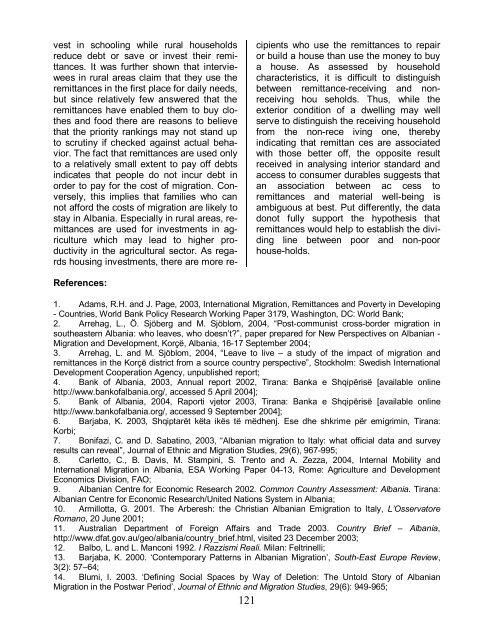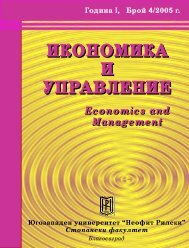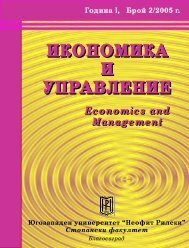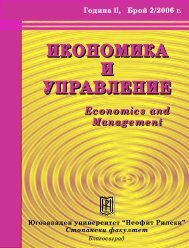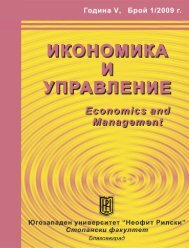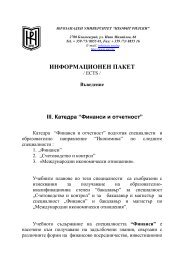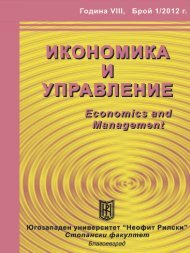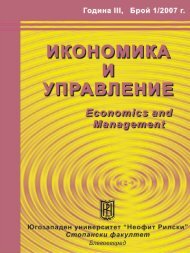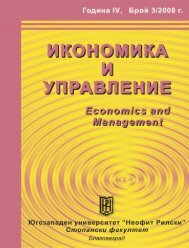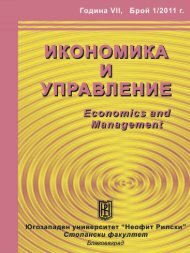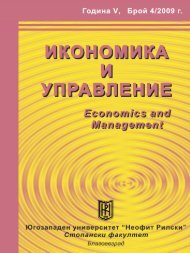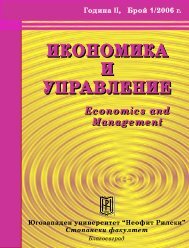ÐÑой 3/2011 - СÑопанÑки ÑакÑлÑÐµÑ - Югозападен ÑнивеÑÑиÑеÑ
ÐÑой 3/2011 - СÑопанÑки ÑакÑлÑÐµÑ - Югозападен ÑнивеÑÑиÑеÑ
ÐÑой 3/2011 - СÑопанÑки ÑакÑлÑÐµÑ - Югозападен ÑнивеÑÑиÑеÑ
You also want an ePaper? Increase the reach of your titles
YUMPU automatically turns print PDFs into web optimized ePapers that Google loves.
vest in schooling while rural households<br />
reduce debt or save or invest their remittances.<br />
It was further shown that interviewees<br />
in rural areas claim that they use the<br />
remittances in the first place for daily needs,<br />
but since relatively few answered that the<br />
remittances have enabled them to buy clothes<br />
and food there are reasons to believe<br />
that the priority rankings may not stand up<br />
to scrutiny if checked against actual behavior.<br />
The fact that remittances are used only<br />
to a relatively small extent to pay off debts<br />
indicates that people do not incur debt in<br />
order to pay for the cost of migration. Conversely,<br />
this implies that families who can<br />
not afford the costs of migration are likely to<br />
stay in Albania. Especially in rural areas, remittances<br />
are used for investments in agriculture<br />
which may lead to higher productivity<br />
in the agricultural sector. As regards<br />
housing investments, there are more recipients<br />
who use the remittances to repair<br />
or build a house than use the money to buy<br />
a house. As assessed by household<br />
characteristics, it is difficult to distinguish<br />
between remittance-receiving and nonreceiving<br />
hou seholds. Thus, while the<br />
exterior condition of a dwelling may well<br />
serve to distinguish the receiving household<br />
from the non-rece iving one, thereby<br />
indicating that remittan ces are associated<br />
with those better off, the opposite result<br />
received in analysing interior standard and<br />
access to consumer durables suggests that<br />
an association between ac cess to<br />
remittances and material well-being is<br />
ambiguous at best. Put differently, the data<br />
donot fully support the hypothesis that<br />
remittances would help to establish the dividing<br />
line between poor and non-poor<br />
house-holds.<br />
References:<br />
1. Adams, R.H. and J. Page, 2003, International Migration, Remittances and Poverty in Developing<br />
- Countries, World Bank Policy Research Working Paper 3179, Washington, DC: World Bank;<br />
2. Arrehag, L., Ö. Sjöberg and M. Sjöblom, 2004, “Post-communist cross-border migration in<br />
southeastern Albania: who leaves, who doesn’t?”, paper prepared for New Perspectives on Albanian -<br />
Migration and Development, Korçë, Albania, 16-17 September 2004;<br />
3. Arrehag, L. and M. Sjöblom, 2004, “Leave to live – a study of the impact of migration and<br />
remittances in the Korçë district from a source country perspective”, Stockholm: Swedish International<br />
Development Cooperation Agency, unpublished report;<br />
4. Bank of Albania, 2003, Annual report 2002, Tirana: Banka e Shqipërisë [available online<br />
http://www.bankofalbania.org/, accessed 5 April 2004];<br />
5. Bank of Albania, 2004, Raporti vjetor 2003, Tirana: Banka e Shqipërisë [available online<br />
http://www.bankofalbania.org/, accessed 9 September 2004];<br />
6. Barjaba, K. 2003, Shqiptarët këta ikës të mëdhenj. Ese dhe shkrime për emigrimin, Tirana:<br />
Korbi;<br />
7. Bonifazi, C. and D. Sabatino, 2003, “Albanian migration to Italy: what official data and survey<br />
results can reveal”, Journal of Ethnic and Migration Studies, 29(6), 967-995;<br />
8. Carletto, C., B. Davis, M. Stampini, S. Trento and A. Zezza, 2004, Internal Mobility and<br />
International Migration in Albania, ESA Working Paper 04-13, Rome: Agriculture and Development<br />
Economics Division, FAO;<br />
9. Albanian Centre for Economic Research 2002. Common Country Assessment: Albania. Tirana:<br />
Albanian Centre for Economic Research/United Nations System in Albania;<br />
10. Armillotta, G. 2001. The Arberesh: the Christian Albanian Emigration to Italy, L’Osservatore<br />
Romano, 20 June 2001;<br />
11. Australian Department of Foreign Affairs and Trade 2003. Country Brief – Albania,<br />
http://www.dfat.gov.au/geo/albania/country_brief.html, visited 23 December 2003;<br />
12. Balbo, L. and L. Manconi 1992. I Razzismi Reali. Milan: Feltrinelli;<br />
13. Barjaba, K. 2000. ‘Contemporary Patterns in Albanian Migration’, South-East Europe Review,<br />
3(2): 57–64;<br />
14. Blumi, I. 2003. ‘Defining Social Spaces by Way of Deletion: The Untold Story of Albanian<br />
Migration in the Postwar Period’, Journal of Ethnic and Migration Studies, 29(6): 949-965;<br />
121


